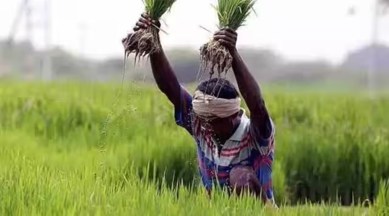Stay updated with the latest - Click here to follow us on Instagram
Area under kharif crop declines by 2.72 lakh hectares in 2023-24
Attributed to delayed monsoon, changing rain pattern leading to losses

At the end of the third week of August, the area under kharif crop has marginally declined by 2.72 lakh hectares. Sowing for 2023-24 has been completed on 137.50 lakh hectares as against 140.22 lakh hectares last year for the same period.
Due to delayed monsoon in the state this year, sowing of kharif crop began only by mid-July instead of mid-June. The erratic rain pattern prompted the state agriculture department to issue an advisory appealing to farmers to not rush with sowing. Farmers were directed to sow only after a minimum of 100 mm rain had fallen in the area to be cultivated.
monthly limit of free stories.
with an Express account.
Despite precautionary measures, frequent intense rainfall played spoiler, thus adversely affecting crops.
Data sourced from agriculture department shows that as against “140.22 lakh hectares under kharif crop last year, the crop this season (2023-24) has been sowed only on 137.50 lakh hectares.” Which means the area under sowing was less in 2.72 lakh hectares.
Agriculture minister Dhananjay Munde has directed officials district wise to provide all necessary help to farmers to ensure a good harvest free of hurdles. Officials are ensuring adequate supply of fertilisers and seeds, to ensure that farmers go for a second round of sowing following losses due to heavy rain.Munde said, “We are committed to the welfare of farmers. Farmers have been trying to maximise gains from the extended monsoon. We have ensured an abundant supply of quality seeds and fertiliser to those going in for a second round of sowing.”
In several districts of Vidarbha, Konkan and parts of North Maharashtra, farmers were forced to sow a second and third time. Incessant rain had led to soil erosion resulting in seeds being washed away in some places. Adding to the issue, floods destroyed crops which were in initial stages of growth, thus forcing farmers to take resolving process.
Farmer leader and president of Swabhimani Shetkari Sanghatana, Raju Shetti, said, “Agriculture has become unpredictable. With changing patterns of rain and wind, farmers are finding it increasingly hard to cope with higher investment and expenditure.”
Shetti said that instead of June, sowing begins late in July due to delayed monsoon and changed rain pattern. Another issue is that an intense spell of rain for a week or fortnight is followed by a long dry spell. Such erratic rain is unsuitable for the kharif crops. It will impact quality and production leading to financial losses to farmers.
According to agriculture department data, the Kolhapur division in Western Maharashtra has seen maximum decline. The area under crop has shrunk by 1.33 lakh hectares, and as against a crop area of 7.33 lakh hectares last season this year, it now stands at 5.99 lakh hectares.
A similar trend has been noticed in Nashik division in North Maharashtra where the area under crop has reduced to 19.63 lakh hectares, against last year’s 20.22 lakh hectares. The Aurangabad division of Marathwada region also recorded a decline from 20.40 lakh hectares to 19.93 lakh hectares. So, too, in Latur in Marathwada region, wherein the crop area has declined from 27.47 lakh hectares to 27.35 lakh hectares. In Western Vidarbha in Amravati, the crop area has reduced from the previous years 30.89 lakh hectares to 30.67 lakh hectares.
The coastal Konkan too was badly hit by heavy rain and thunderstorms. The area under crop was lower from last year’s 3.98 lakh hectares to 3.82 lakh hectares.
However, Nagpur division with sowing on 18.59 lakh hectares showed an increase as compared with last year’s 18.50 lakh hectares. Equally positive was the trend in Pune division where area under kharif crop sown improved at 11.48 lakh hectares as against last year’s 11.40 lakh hectares.
Highly placed sources in the agriculture department said, “Generally, kharif sowing stretches from June and July end. But climatic changes have impacted the sowing cycle with farmers hitting sowing seeds till mid-August.”